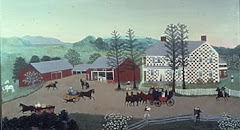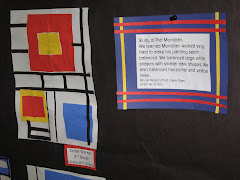Two week Reflection:
In the first two weeks I have learned to set up a blog, a "de.licio.us" account and attempted to do a voice thread. All this!!-- from someone who doesn't "text" or "myspace"!! I've come a long way baby!!
Things I need to learn:
--how do I put a picture from the text CD onto my blog or my voice thread?
( I put the CD onto my desktop but that didn't work...
--how do I put it on my hard drive?? anyone?? --really
--how to move around within the voice thread program--(I got lost a time or two--but it's fun!)
Most meaningful or relevant material/ information:
I appreciate the Blog #3 assignment being place in the Learning Unit Section.
(less to seek after and possibly miss?)
Once I had gotten my feet technically "wet" in the tech world
I was able to relax and enjoy the entire process.
Overall it's been a positive experience
Sunday, January 27, 2008
Monday, January 21, 2008
#2 Critical Analysis
Smithson's spiral jetty in Utah is fulfilling the "fourth traditional role of the artist".
This fourth role of the artist is "meant to help us see the world in a knew or innovative way." This role is "designed to transform our experience of the world, jar us out of our complacency and create new ways for us to think about the world around us."(page 8, text)
Bierstadt's(Rocky mountains) Chen's (The Central Mountain) and Smithson's Spiral Jetty have commonality in that they are all working within the boundaries of nature and at the same time using their "tools" in a way that changes the way we might view a particular site through their art mediums in a new way. While they are each using the voice of nature, they are culturally speaking their own experience and reality through their works. For example, Bierstadt paints in oil on canvas a landscape which might exist in America. He had actually painted the Alps as he was a trained painter in Europe. He saw American landscapes culturally through European eyes perhaps as the text says : "even secretly longing for America to be Europe." (page 5, text) He works as an artist that wants "to record the world but only as he sees it "and he wants us to share that with him. (page 5)
Chen works in the second traditional role of the artist: "to give visible or tangible form to ideas, philosophies, or feelings." (page 6,text) In this way Chen and Bierstadt differ in their message but not their mode. Chen reveres nature while Bierstadt is ready to recreate what nature has wrought to recreate his own experience. The spiral jetty holds commonality with the Chinese culture's yin and yang and the Egyptian culture's spiral designating the"motion of cosmic forms and the relationship between unity and multiplicity." (page 9, text)
As each thread in a tapestry is woven to depict the artist's message or view I feel that each artist's work are all as intertwined with each other yet distinct from one another.They are intertwined culturally, historically and individually. Different in their world view culturally, yet similar in that they want to tell the world what they see, feel or believe through natural landscapes.
In dramas or written works or music there usually is a "back story". Had I not read each artist's "back story" their work may not have had much more meaning to appreciate. For instance, knowing the common threads between the Egyptians and the Chinese symbolisms and the "living" work that the Jetty is gives me more "meat" to chew on---something deeper than an appreciation for the scope, scale and living art.
M. Martino
This fourth role of the artist is "meant to help us see the world in a knew or innovative way." This role is "designed to transform our experience of the world, jar us out of our complacency and create new ways for us to think about the world around us."(page 8, text)
Bierstadt's(Rocky mountains) Chen's (The Central Mountain) and Smithson's Spiral Jetty have commonality in that they are all working within the boundaries of nature and at the same time using their "tools" in a way that changes the way we might view a particular site through their art mediums in a new way. While they are each using the voice of nature, they are culturally speaking their own experience and reality through their works. For example, Bierstadt paints in oil on canvas a landscape which might exist in America. He had actually painted the Alps as he was a trained painter in Europe. He saw American landscapes culturally through European eyes perhaps as the text says : "even secretly longing for America to be Europe." (page 5, text) He works as an artist that wants "to record the world but only as he sees it "and he wants us to share that with him. (page 5)
Chen works in the second traditional role of the artist: "to give visible or tangible form to ideas, philosophies, or feelings." (page 6,text) In this way Chen and Bierstadt differ in their message but not their mode. Chen reveres nature while Bierstadt is ready to recreate what nature has wrought to recreate his own experience. The spiral jetty holds commonality with the Chinese culture's yin and yang and the Egyptian culture's spiral designating the"motion of cosmic forms and the relationship between unity and multiplicity." (page 9, text)
As each thread in a tapestry is woven to depict the artist's message or view I feel that each artist's work are all as intertwined with each other yet distinct from one another.They are intertwined culturally, historically and individually. Different in their world view culturally, yet similar in that they want to tell the world what they see, feel or believe through natural landscapes.
In dramas or written works or music there usually is a "back story". Had I not read each artist's "back story" their work may not have had much more meaning to appreciate. For instance, knowing the common threads between the Egyptians and the Chinese symbolisms and the "living" work that the Jetty is gives me more "meat" to chew on---something deeper than an appreciation for the scope, scale and living art.
M. Martino
Sunday, January 20, 2008
#1 "All About Me"
Marilyn here. This is my third year at Sierra College and am a first time blogger! I am a Early Childhood Education major and will be transferring to Sacramento State in the fall !! This class will allow me to graduate this spring at the master teacher level and give me a bigger picture into the world of art. I truly am a "newbie"...I know my preferences but am looking to expand my horizons.
More than anything I love observing and participating in the process of art with children. Both my husband's family and mine are very artistic so our children have benefited from that. They are very creative and use whatever they have to expresss their artistic nature. (love that about kids)
This past summer my 10 year old daughter and I saw the Grandma Moses exhibit at the Crocker Museum. (I finally know how to get there!!) We must have walked through the exhibit at least twice. What astounded me was her tools and paint. Very simple.She used what she had or what was available. The quality of her materials did improve though as she continued painting over time.
We tried to "choose" a favorite and I could not. She chose the Red and White Checkered Barn though. It is unique. We eventually ended up in the gift shop and we purchased a bookmark with a Grandma Moses postage stamp picturing a farm scene. Her quote says, "Life is what we make it, always has been and always will be."
Thanks for reading!! Marilyn
More than anything I love observing and participating in the process of art with children. Both my husband's family and mine are very artistic so our children have benefited from that. They are very creative and use whatever they have to expresss their artistic nature. (love that about kids)
This past summer my 10 year old daughter and I saw the Grandma Moses exhibit at the Crocker Museum. (I finally know how to get there!!) We must have walked through the exhibit at least twice. What astounded me was her tools and paint. Very simple.She used what she had or what was available. The quality of her materials did improve though as she continued painting over time.
We tried to "choose" a favorite and I could not. She chose the Red and White Checkered Barn though. It is unique. We eventually ended up in the gift shop and we purchased a bookmark with a Grandma Moses postage stamp picturing a farm scene. Her quote says, "Life is what we make it, always has been and always will be."
Thanks for reading!! Marilyn
Subscribe to:
Comments (Atom)






















